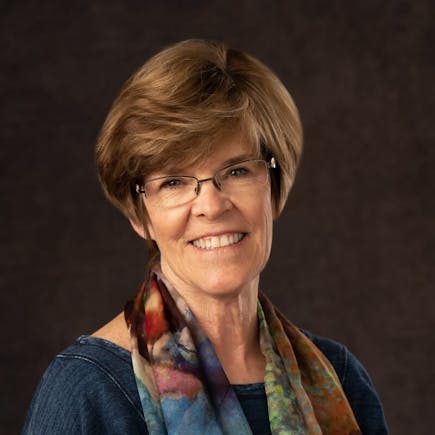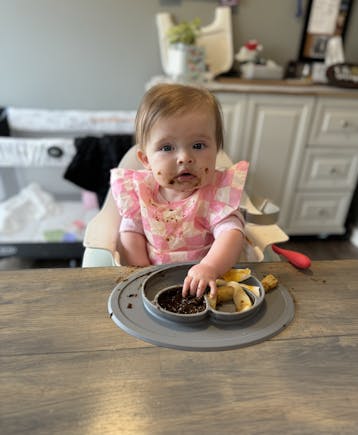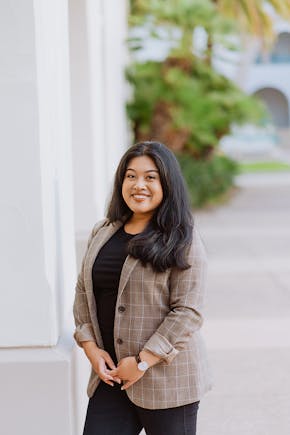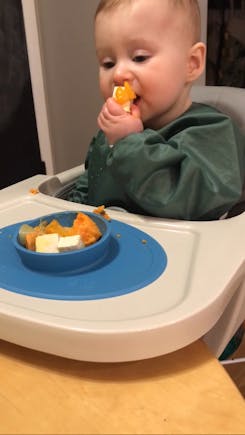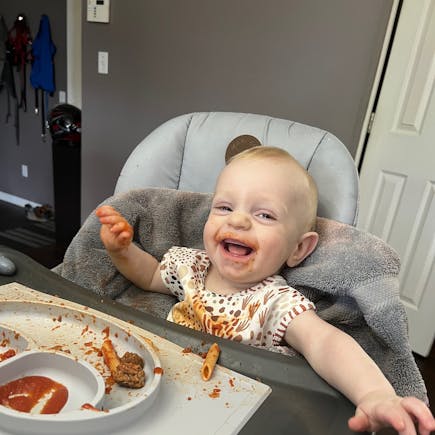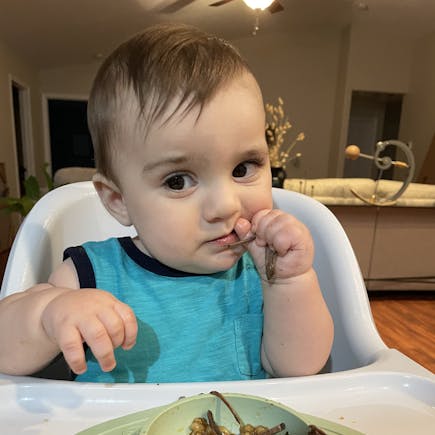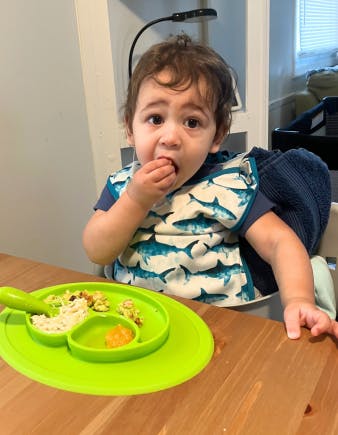What is Baby-Led Weaning?
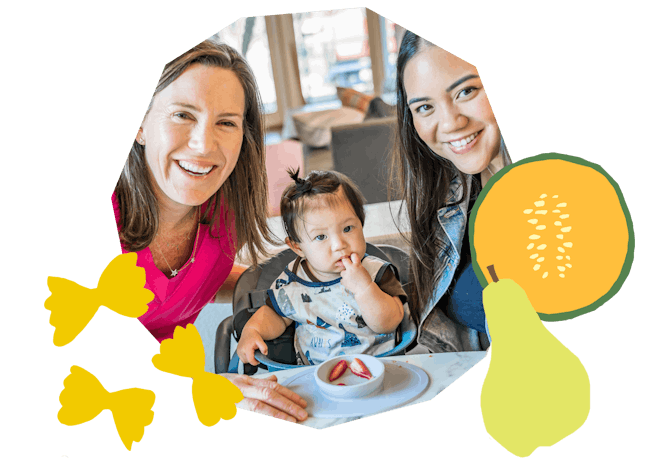
Your baby can eat real food
Babies can eat so many more foods than we give them credit for! Baby-led weaning is an alternative to conventional adult-led spoon feeding whereby babies learn to feed themselves wholesome, safe foods offered by parents and caregivers. Baby-led weaning is a responsive feeding method that supports the baby’s inborn ability and desire to be an active participant in the transition to solid foods.
History of baby-led weaning
The baby-led weaning movement was started by Gill Rapley, PhD, a British health visitor and co-author of the original baby-led weaning book, first published in 2008. (Click here for the most current version of the book) Rapley advocated for waiting until babies are 6 months of age and are demonstrating the other reliable signs of readiness to eat before starting solid foods. This was in stark contrast to earlier practices that advocated starting solid foods at - or sometimes even before - 4 months of age.
This is nothing new…
While baby-led weaning is a relatively new term and parenting phenomenon, the baby-led weaning approach and philosophy is millennia old.
Different cultures and ethnic groups around the world have historically offered and continue to offer their babies modified versions of the same foods the rest of the family eats.
Contrast that with commercial baby food, a largely Western invention that has only been available and marketed since the earlier part of the twentieth century.
Benefits of baby-led weaning
With the baby-led weaning feeding method, the focus is on allowing the baby to learn how to eat, with less emphasis and pressure on how much the baby is consuming. The benefits of baby-led weaning include:
- Increased feeding autonomy and participation in family meals from the baby’s first bites
- Reduced risk of selective (i.e., “picky”) eating later in toddlerhood
- Decreased risk of food allergies due to earlier exposure of potentially allergenic foods
With the baby-led approach, babies learn to recognize and respond to their inborn hunger and satiety cues.
Learn more about baby-led weaning
If you want to learn more about giving your baby a safe start to solid foods using baby-led weaning, sign up for my free online video workshop called BABY-LED WEANING FOR BEGINNERS. Everyone on this free training gets a copy of my original 100 FIRST FOODS™ list and you can register here.
“Baby-led weaning is about the feeding being done by the baby…not to the baby.”
— Gill Rapley, PhD
What parents and caregivers are saying about Baby-Led Weaning with Katie Ferraro...
FAQs about baby-led weaning
Baby-led weaning is a safe and effective alternative to conventional, adult-led spoon feeding. Starting solid foods can be scary no matter what approach you take…but it may help to know that research demonstrates there is no higher risk of choking with a baby-led approach compared to conventional adult-led spoon-feeding, provided that parents are educated about reducing choking risk.
If you would like to learn more about the research that supports a baby-led approach to starting solid foods, read this review article by Professor Amy Brown, PhD of Swansea University called Baby-Led Weaning: The Evidence to Date. I also interviewed Dr. Brown on my podcast in this episode “The Evidence Behind Baby-Led Weaning with Amy Brown, PhD”.
Choking is a very rare - but real risk, and I recommend that all parents and caregivers take an infant refresher CPR course before starting solid foods. CPR saves lives and the online CPR course that I take each quarter is a very affordable way to get your CPR skills up to snuff.
Click here for the online CPR course and the Choking Prevention and Response course I co-teach. The affiliate discount code KATIE10 works for $10 off each of those online programs and you can register here.
There is no shortage of misinformation about baby-led weaning! One myth about baby-led weaning is that it means just skipping purees…which it certainly does not.
Purees are an important texture for your baby to master…they’re just not the only texture your baby can eat!
You can honor the self-feeding principles of baby-led weaning and still let your baby self-feed naturally puree-like foods such as full-fat, whole milk yogurt, unsweetened applesauce or whole-grain (non-rice) cereal or porridge. We do this using the pre-loaded spoon technique.
The pre-loaded spoon is a term and technique coined and developed by Dawn Winkelmann, MS, CCC-SLP, a pediatric feeding expert and designer of the award-winning baby-led weaning spoon for ezpz called the Tiny Spoon.
You can learn more about the pre-loaded spoon technique from Dawn on this podcast interview How to Pre-Load A BLW Spoon Self-Feeding Technique with Dawn Winkelmann, MS, CCC-SLP.
If the thought of jumping right from infant milk to soft solid foods for your baby is kind of freaking you out, you are not alone!
Many parents mistakenly think that spoon-feeding your baby is safer than letting them self-feed….but putting any object in your baby’s mouth - including a spoon - can be a choking hazard.
Babies who are 6 months of age (or 6 months adjusted age if born prematurely) and demonstrating the other reliable signs of readiness to eat can safely self-feed soft strips of properly prepared food.
You can learn more about the limitations of “combo feeding” from Gill Rapley, the co-author of the original baby-led weaning book and founding philosopher of the baby-led weaning movement in this podcast interview episode: Combo Feeding: Can I Do BLW + Traditional Spoon-Feeding Together? with Gill Rapley, PhD
If you’d like to learn more about my Purees for a Few Days™ transition to solid foods system, I teach about this on my free 75-minute online video workshop called BABY-LED WEANING FOR BEGINNERS.
You can take this on-demand free training right now, a little later today or tomorrow. Click here to register for the free workshop (and this is also the training where you can get a copy of my original 100 First Foods™ list too.)
I know it’s tempting to cut up foods very small for your baby. It’s human nature to think that smaller = safer (especially for a baby who has never had anything except infant milk in their mouth!)…but the opposite is true when it comes to early eaters.
Your early eater who is 6 or 7 or even 8 months of age does not have their pincer grasp. That means they can’t pick up small pieces of food and bring it to their mouth, which is a core tenet of baby-led weaning.
Early on in baby-led weaning your baby is using their whole hand - or palmar grasp - to rake and scoop food into their hand and up into their mouth. To this effect, we cut soft pieces of food for baby-led weaning in sticks or spears about the size of your adult pinky finger.
The adult pinky finger sized pieces are adequately long and wide enough for your baby to rake and scoop the food up into their hand and mouth and safely self-feed. If the baby breaks off a piece of long food into a smaller piece in their mouth on their own, the baby is the one who is driving the eating experience and the baby is in control: this is baby-led weaning in action.
The baby might move that smaller piece of food to the back of their mouth, gag if it is uncomfortable, spit the food out or move it forward or move it around in their mouth…eventually learning how to safely chew and swallow food.
With baby-led weaning, we trust that the baby who is demonstrating the reliable physiological signs of readiness to eat can safely self-feed. Our job as parents and caregivers is to safely prepare foods, offer them in a safe feeding environment and at set meal times.
Ultimately it is up to the baby to determine how much - or even whether they want to eat. This is Ellyn Satter’s Division of Responsibility in Feeding Theory in action and it applies perfectly to the baby-led weaning model.
If we force small pieces of food into the mouth of an early eater, we have removed the baby’s autonomy to self-feed and if the baby is not the one driving the eating experience, that is not baby-led weaning.
Preparing baby-led weaning foods properly is the most important consideration for giving your baby a safe start to solid foods.
Inside of my digital program called BABY-LED WEANING with Katie Ferraro I show you exactly how to prepare all of the 100 foods on my 100 FIRST FOODS™ list.
With this program you get instant and lifetime access to all of the instructions and recipes you need to succeed…so you don’t have to hunt and peck all over the internet trying to figure it out on your own or relying on other resources that don’t really show you how to correctly prep your baby’s food.
There is no scientific basis for or peer-reviewed, published infant feeding guideline to support the recommendation to wait 3-5 days between new foods for babies.
Many doctors still incorrectly recommend waiting 3-5 days between new foods, claiming that the “waiting period” is intended to give parents and caregivers a chance to observe for any allergic reaction to the new food.
The reality is: if your baby is going to have an allergic reaction to food, the vast majority of allergic food reactions will occur within minutes and up to no more than 2 hours following ingestion.
In fact, new research points to the importance of introducing MORE foods to babies during the all-important flavor window when they will like and accept a wide variety of foods and flavors and tastes and textures.
I know it can sound scary to offer your baby a food that could potentially cause an allergic reaction. But the reality is, the only way to know if your baby is allergic to food is to offer your baby that food.
Here’s a helpful podcast interview I did on this topic if you’d like to learn more: What do I do if My Baby Has an Allergic Reaction? with Ron Sunog, MD.
Another thing to keep in mind is that the only way to lower your baby’s risk of allergic reaction is to actually offer them the allergenic foods early and often.
Inside of my program BABY-LED WEANING with Katie Ferraro, we start offering your baby the BIG 9 allergenic foods (those are the 9 foods that account for about 90% of food allergy) and we do that beginning in week 1 of baby-led weaning.
My program walks you through the first 100 days of solid foods and exactly HOW to start solid foods and most importantly: how to safely prep all 100 of the foods on the 100 FIRST FOODS LIST (including all of the allergenic foods).
There is no hard and fast rule about how much or how often to offer the allergenic foods, but my program will teach you how to make those foods safely for your baby’s current age and stage so that you can successfully use food to help lower the risk of food allergy.
You do not need to buy gimmicky, expensive subscription supplement programs to introduce allergenic food proteins to your baby. Your baby can learn how to eat all of the potentially allergenic foods - using food as the source of the food protein - starting at 6 months of age.
It can be challenging when you feel like you have to “defend” your decision not to force-feed your baby by spoon!
Baby-led weaning is a safe and effective alternative to conventional, adult-led spoon feeding that has numerous benefits, including:
- Increased feeding autonomy and participation in family meals from the baby’s first bites
- Reduced risk of selective (i.e., “picky”) eating later in toddlerhood
- Decreased risk of food allergies due to earlier exposure of potentially allergenic foods.
I have a number of resources to help you explain baby-led weaning and get others in your tribe on board with this approach too:
- Read this article to understand the basics of baby-led weaning: What is Baby-Led Weaning?
- Listen to these podcast episodes: Getting Grandparents on Board: BLW Across Generations and Grandparents, Spouses & Partners: Getting Others on Board with BLW
- Read this free feeding guide: BLW + Daycare: How to Be a Baby-Led Weaning Advocate at Daycare (this requires an email address to download the free feeding guides on this site and I never sell or redistribute your personal information or email address).
If you are looking for a supportive community of like-minded parents to learn more about baby-led weaning with, my digital program BABY-LED WEANING with Katie Ferraro may be a good fit for you. Click here to learn more about joining and helping your baby get a safe start to solid foods.
Ugh. There’s nothing worse than coming strong out of the gate with some simple starter foods like avocado, banana and sweet potato…and then getting stuck.
This happens all the time: families are gung ho about baby-led weaning for the first week or two...and then they run out of ideas of foods to feed.
When I was starting baby-led weaning with my quadruplets, I really struggled with which foods to feed my babies after the simple starter foods too.
They weren’t getting enough iron rich foods, we weren’t doing the allergenic foods at first…all of which is exactly why I created my original 100 FIRST FOODS™ approach to starting solid foods with baby-led weaning - so that NOBODY would ever run out of ideas of foods to offer their baby next.
If you want to learn more about this approach and get your free copy of my original 100 FIRST FOODS list, I give it away to everyone on my free on-demand video workshop called BABY-LED WEANING FOR BEGINNERS. This is a 75 minute training that you can take right now, later today or tomorrow. Click here to register for the free workshop.
If you’re already committed to the idea of getting your baby to eat 100 safe, baby-led weaning foods before turning one, my digital program BABY-LED WEANING with Katie Ferraro is for you!
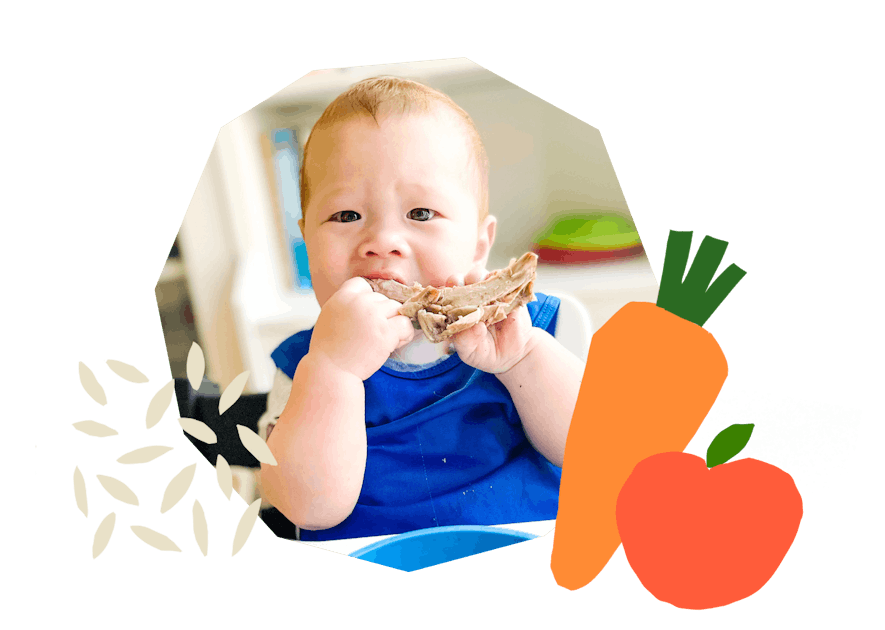
The Program Baby-Led Weaning with Katie Ferraro
A step-by-step digital program for starting solid foods safely and navigating the original 100 FIRST FOODS™ meal plan with baby-led weaning.
 EXPERT-LED, PROVEN APPROACH TO EATING REAL FOOD
EXPERT-LED, PROVEN APPROACH TO EATING REAL FOOD CONCISE VIDEO TRAININGS TO MASTER BABY-LED WEANING
CONCISE VIDEO TRAININGS TO MASTER BABY-LED WEANING 100 FIRST FOODS DAILY MEAL PLAN WITH FOOD PREP VIDEOS
100 FIRST FOODS DAILY MEAL PLAN WITH FOOD PREP VIDEOS
Get baby-led weaning recipes and tips delivered to your email inbox.

